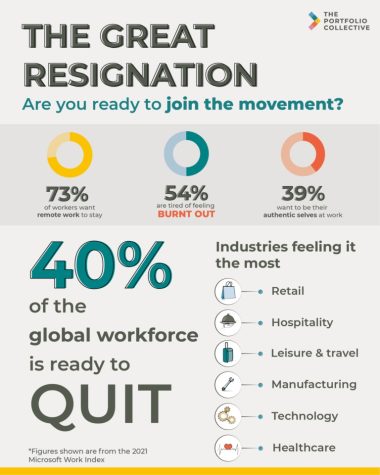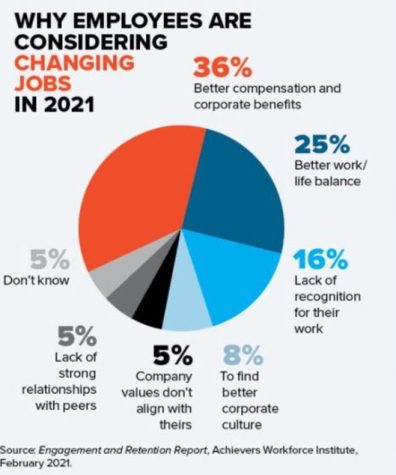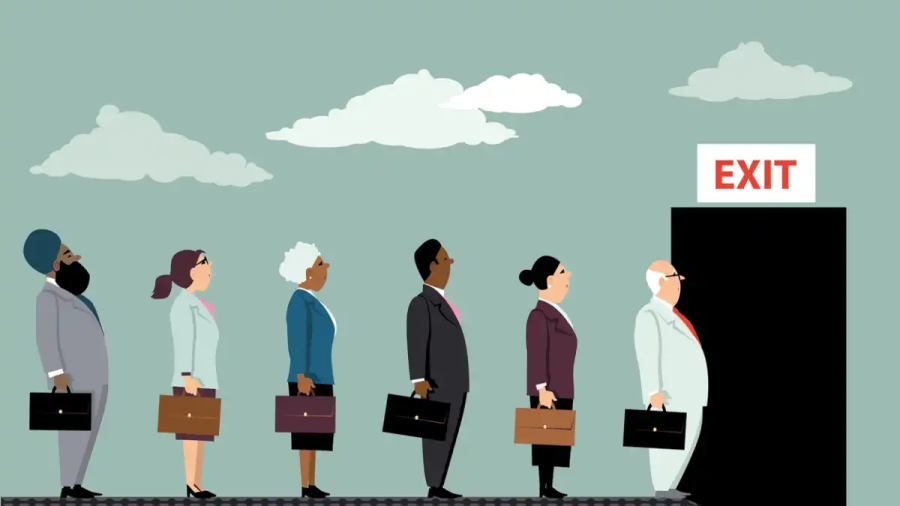Employment Crisis – The Great Resignation
April 3, 2022
The Great Resignation, also known as the Big Quit, is an ongoing economic trend that began in the early months of 2021. On the surface, the pandemic caused many to rethink their work-life balance after months of high intensity work and other external pressures. However, this trend also ties into the many complexities of the economy and the people that support it.
According to the U.S. Bureau of Labor Statistics, a little over 4 million Americans voluntarily left their positions in July 2021, and 4.5 million — an all time high — in November of the same year.
Abnormally high rates of resignation over the last few months have also left a record-breaking 10.9 million jobs open at the end of July 2021. Employers have had harder times filling these open positions as the labor force participation rate remains significantly smaller than before the pandemic.
“I think that with the great resignation, more people see that there are other opportunities and… other ways to feed their family,” said Ms. Abraham, NYC Museum School art and health teacher. “That if they don’t like something, they don’t have to be tied to it.” Some even resigned due to a desire to stay remote in contrast to long, eight-hour work days in-person. “I could be in Thailand and still be doing my job,” Ms. Abraham added.
Demographic trends of the Great Resignation reveal that turnover usually highest among workers aged 20 to 25 actually decreased in the last year. This was likely a result of greater financial uncertainty and reduced demand for entry-level jobs. On the other hand, employees between 30 and 45 years have experienced a significant increase in resignation rates. Those aged 25 to 30 and 45+ also had slight increases.
Resignation rates were also higher among employees in fields that had experienced extreme increases in demand due to the pandemic. 3.6% more health care and 4.5% more tech employees quit their jobs than in the previous year.

Parents of children under 18 also had their careers heavily impacted by the pandemic, largely as an extension of the transitioning to remote learning. Assistant Principal Ms. Hindelong, who is also mother of two young children said, “I was in a place where I could get them the care they needed so I could return to work. But I know of teachers who did not return and stayed at home with their young children because of Covid.”
One reason to explain the significant increase in turnover for mid-career employees could be their level of experience, which grants them greater leverage in securing new positions. The shift to remote work during the pandemic created a greater feeling of risk for employers to hire young employees with little experience, especially considering that they would not be able to receive as much in person training and guidance.
Another possibility could be that The Great Resignation is simply a delayed and accumulated response from the workforce. The pandemic’s uncertainty back in 2021 may have withheld employees from resigning, leading the increases seen over the last several months to be the result of a year’s worth of resignations.
However, some are taking a look at this whole phenomenon in a different perspective. Planet Money, a podcast on economics, believes in coining this current period as “The Great Renegotiation” instead. Karin Kimbrough, the chief economist of LinkedIn, approved of this rebranding, stating, “There are twice as many jobs on our platform as there were a year ago.” And his abundance of opportunity grants more experienced workers in particular the ability to negotiate a better position.
 One of the most important factors driving the Great Resignation is inflation. Forbes states, “Employees who stay in companies longer than two years get paid 50% less.” 50% is the lowest observed on the spectrum, although this doesn’t weaken the general argument that employee loyalty to a company or institution is not always recognized, and that there are material benefits to jumping ships.
One of the most important factors driving the Great Resignation is inflation. Forbes states, “Employees who stay in companies longer than two years get paid 50% less.” 50% is the lowest observed on the spectrum, although this doesn’t weaken the general argument that employee loyalty to a company or institution is not always recognized, and that there are material benefits to jumping ships.
Politically, American leaders over the course of 2021 claimed that inflation would be temporary. However, with the prices of everyday goods going up and employees beginning to demand higher salaries, companies are in turn starting to charge more for their products in order to pay their employees more. This could be described as an inflationary cycle that reveals a potentially dangerous aspect to The Great Resignation.
In the short term, this economic trend seems great for many American workers, especially as they begin to see gains in their material standard of living after years of stagnant pay. In the long term however, it is uncertain whether this trend will become fuel for a wage-price spiral that leaves most Americans worse off.
Despite the additional stress and challenges that come with learning and teaching in a remote remote setting, the impacts of the Great Resignation have not greatly impacted Museum school. Ms. Abraham believes that she fared well during the pandemic largely due to her ability to embrace technology. She was able to transition her students to digital art with online drawing platforms such as photoshop and sketchbook.
In another example of embracing change, Ms. Ng, the AP Language and Composition teacher said, “At my old school, many teachers didn’t want to go live. I went live every day.”
While the pandemic certainly did not make it an easy time for everyone, many appreciated the benefits of being remote. When Sei Sensei, the Japanese foreign language teacher, was asked if she had considered quitting during the pandemic, she responded, “No, not at all… I am lucky because I have coworkers who are supportive… and students who are good.” The pandemic even gave her more time with her family and dogs.










































